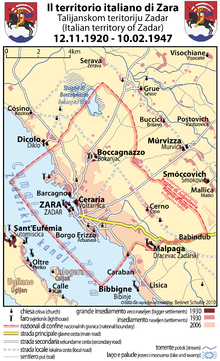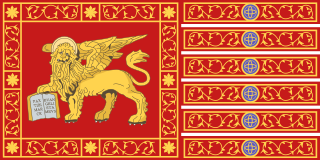
This is a list of prefects of the Province of Zara (now modern Zadar and its surrounding area, in Croatia).

This is a list of prefects of the Province of Zara (now modern Zadar and its surrounding area, in Croatia).
| Tenure | Portrait | Incumbent | Notes |
|---|---|---|---|
| Italian suzerainty | |||
| 19 November 1918 to 23 January 1921 |  | Enrico Millo | Military Governor; officially styled Governor of Dalmatia [1] |
| 23 January 1921 to 14 July 1921 | Corrado Bonfanti Linares | Civil Commissioner for Dalmatia | |
| 16 July 1921 to 1 November 1922 | Amadeo Moroni | ||
| 1 November 1922 to 16 May 1923 | Luigi Maggioni | ||
| 16 May 1923 to 1 August 1924 | Corrado Tamajo | ||
| 1 August 1924 to 11 December 1925 | Giulio Basile | ||
| 11 December 1925 to 1 February 1929 | Pietro Carpani | ||
| 1 February 1929 to 1 December 1932 | Marcello Vaccari | ||
| 1 December 1932 to 30 June 1933 | Carlo Solmi | ||
| 1 July 1933 to 20 January 1934 | Efisio Baccaredda | ||
| 20 January 1934 to 21 August 1939 |  | Edoardo Spasiano | |
| 21 August 1939 to 7 June 1941 | Giovanni Zattera | ||
| 7 June 1941 to 26 October 1941 | Manlio Binna | ||
| 26 October 1941 to 26 May 1942 | Vezio Orazi | ||
| 26 May 1942 to 1942 | Camillo Bruno | Acting | |
| 1 September 1942 to 1 August 1943 | Gaspero Barbera | ||
| 1943 | Alberto, conte Degli Alberti | Acting | |
| German occupation | |||
| 2 November 1943 to 30 October 1944 |  | Vincenzo Serrentino | Appointed on behalf of the Italian Social Republic |
| 30 October 1944 to 31 October 1944 |  | Giacomo Vuxani | Acting; appointed on behalf of the Italian Social Republic |
| 31 October 1944 | Liberated by Yugoslav Partisans | ||
| 2 November 1944 | Incorporated into the SFR Yugoslavia as part of the SR Croatia ; renamed Zadar | ||


| Tenure | Portrait | Incumbent | Notes |
|---|---|---|---|
| 10 September 1943 to 1 December 1943 | Karl Eglseer | Commander of the 114th Jäger Division | |
| 1 December 1943 to 18 April 1944 | Albin Nake | Commander of the 264th Infantry Division | |
| 18 April 1944 to 15 May 1944 | Otto-Joachim Lüdecke | ||
| 15 May 1944 to 25 September 1944 |  | Martin Gareis | |
| 25 September 1944 to 9 October 1944 | Paul Hermann | ||
| 9 October 1944 to 31 October 1944 | Alois Windisch | ||
| 31 October 1944 | Liberated by Yugoslav Partisans | ||

Dalmatia is one of the four historical regions of Croatia, alongside Central Croatia, Slavonia, and Istria, located on the east shore of the Adriatic Sea in Croatia.

Zadar is the oldest continuously inhabited city in Croatia. It is situated on the Adriatic Sea, at the northwestern part of Ravni Kotari region. Zadar serves as the seat of Zadar County and of the wider northern Dalmatian region. The city proper covers 25 km2 (9.7 sq mi) with a population of 75,082 in 2011, making it the second-largest city of the region of Dalmatia and the fifth-largest city in the country.

The Kingdom of Dalmatia was a crown land of the Austrian Empire (1815–1867) and the Cisleithanian half of Austria-Hungary (1867–1918). It encompassed the entirety of the region of Dalmatia, with its capital at Zadar.
The History of Dalmatia concerns the history of the area that covers eastern coast of the Adriatic Sea and its inland regions, from the 2nd century BC up to the present day. The region was populated by Illyrian tribes around 1,000 B.C, including the Delmatae, who formed a kingdom and for whom the province is named. Later it was conquered by Rome, thus becoming the province of Dalmatia, part of the Roman Empire. Dalmatia was ravaged by barbaric tribes in the beginning of the 4th century.

The Treaty of Zadar, also known as the Treaty of Zara, was a peace treaty signed in Zadar, Dalmatia on February 18, 1358. Under the treaty, the Venetian Republic lost influence over its Dalmatian holdings in exchange for ending hostilities with Louis I of Hungary. Both had been contesting control of a series of territories along the eastern Adriatic coastline in what is now Croatia.

The bombing of Zadar during the Second World War by the Allies lasted from November 1943 to October 1944. Although other large cities in Italy were also bombed, the bombing of Zadar stands out because of the number of attacks and the number of fatalities. Reports vary greatly; the Allies documented 30 bombing raids, while contemporary Italian accounts claim 54. Fatalities recorded range from under 1,000 to as many as 4,000 of the city's 20,000 inhabitants.

The Archdiocese of Zadar is a Latin Church ecclesiastical territory or archdiocese of the Catholic church in Croatia. The diocese was established in the 3rd century AD and was made an archdiocese by the Pope Anastasius IV in 1154. Today, it is not part of any ecclesiastical province of Croatia, rather it is the only Croatian archdiocese directly subject to the Holy See.

Dalmatian Italians are the historical Italian national minority living in the region of Dalmatia, now part of Croatia and Montenegro.

Stjepan Jovanović was a military commander of the Austrian Empire from the Military Frontier.

The Governorate of Dalmatia was an administrative division of the Kingdom of Italy, established in 1941, following the military conquest of Yugoslavian Dalmatia by General Vittorio Ambrosio, during World War II. It had the provisional purpose of progressively importing Italian national legislation in Dalmatia in place of the previous one, thus fully integrating it into the Kingdom of Italy.
The Autonomist Party was an Italian-Dalmatianist political party in the Dalmatian political scene, that existed for around 70 years of the 19th century and until World War I. Its goal was to maintain the autonomy of the Kingdom of Dalmatia within the Austro-Hungarian Empire, as opposed to the unification with the Kingdom of Croatia-Slavonia. The Autonomist Party has been accused of secretly having been a pro-Italian movement due to their defense of the rights of ethnic Italians in Dalmatia. The Autonomist Party did not claim to be an Italian movement, and indicated that it sympathized with a sense of heterogeneity amongst Dalmatians in opposition to ethnic nationalism. In the 1861 elections, the Autonomists won twenty-seven seats in Dalmatia, while Dalmatia's Croatian nationalist movement, the National Party, won only fourteen seats. This number rapidly decreased: already in 1870 autonomists lost their majority in the Diet, while in 1908 they won just 6 out of 43 seats.

Pier Alessandro Paravia was born in Zara, Dalmatia on July 15, 1797 and was a Dalmatian Italian writer, scholar, philanthropist and professor of Italian eloquence at the University of Turin.

Italians of Croatia are an autochthonous historical national minority recognized by the Constitution of Croatia. As such, they elect a special representative to the Croatian Parliament. There is the Italian Union of Croatia and Slovenia, which is a Croatian-Slovenian joint organization with its main site in Rijeka, Croatia and its secondary site in Koper, Slovenia.

Italian irredentism in Dalmatia was the political movement supporting the unification to Italy, during the 19th and 20th centuries, of Adriatic Dalmatia.

The Province of Zara was a province of the Kingdom of Italy, officially from 1918 to 1947. In 1941 it was enlarged and made part of the Italian Governorate of Dalmatia, during World War II, until 1943.

Venetian Dalmatia refers to parts of Dalmatia under the rule of the Republic of Venice, mainly from the 15th to the 18th centuries. Dalmatia was first sold to Venice in 1409 but Venetian Dalmatia was not fully consolidated until 1420. It lasted until 1797, when the Republic of Venice fell to the forces of Napoleon Bonaparte and Habsburg Austria.

Dalmatian city-states were the Dalmatian localities where the local Romance population survived the Barbarian invasions after the fall of the Western Roman Empire in the 400s CE. Eight little cities were created by indigenous inhabitants who maintained political links with the Eastern Roman Empire which defended these cities, enabling their commercial trade.

The siege of Zadar was a successful attempt of the Republic of Venice to capture Zadar, a Croatian coastal city in northern Dalmatia. It was a combined land and sea offensive by the Venetians, consisting of many separate battles and operations against the citizens of Zadar, who refused to accept Venetian suzerainty and demanded autonomy. Despite receiving military aid from Croato-Hungarian king Louis the Angevin, Zadar was unable to resist the siege and was finally defeated.
Vincenzo Duplancich was a Dalmatian Italian journalist, writer, politician, and nationalist. He promoted Italian culture and the preservation of Italian identity in Dalmatia, firmly opposing the annexation of the latter to Croatia. He was active during and within the Risorgimento.

Lucio Toth was a Dalmatian Italian politician.